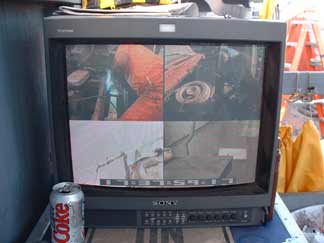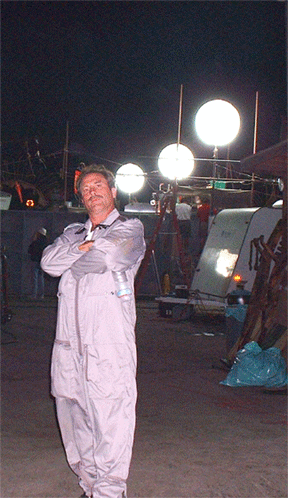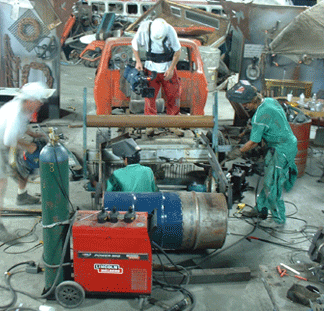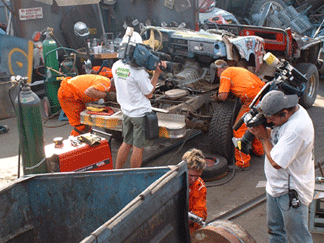

The Junkyard Wars set is located on the outskirts of Los Angeles in an industrial area. At the front of the actual junkyard is an air-conditioned trailer where personnel can take a break, as well as a lounge area with a tarp cover. The seating arrangements are mostly bench seats taken, presumably, from cars that have cycled through the junkyard over time.
A fence separates the front from the corral-like area where the two teams work. The two work areas, which are separated by a tall fence that keeps the teams from viewing each other, are both outfitted with a variety of fabrication tools and equipment. The camera crews for each team are monitored from twin towers that extend above the fence, one located at the end of each team's work area. The director gets a tower of his own, located at the end of the fenceline such that he can watch both teams in action.
On the day of the shoot it was quite hot, especially with all the metal in the area that both picked up and reflected the heat. So, I tried to wangle my way onto one of the covered platforms as often as I could. Unfortunately, these small areas were often crowded with cameramen and others who actually had a job there, so I had to be in the sun more than my Pacific Northwest body was used to. Since that was the only vantage point from which pictures could be taken, however, the crew was nice enough to let me have some time up with them.
Although the TLC folks had initially only committed to allowing me on the set for an hour, by staying out of the way I managed to extend my stay throughout the day's events, and was even invited back for the testing phase. Thanks to all for their hospitality!
A large piece of sun-filtering fabric was stretched over the top of the two work areas, to keep the two teams from being in the direct sun. Still, dressed in their fireproof jumpsuits it had to be close to unbearable for them. Fortunately, they were all moving so fast trying to get a sweeper built that there probably wasn't any time to dwell on so minor a problem.

In each viewing tower was a video monitor with views of the four cameras that were simultaneously shooting each team's work. Periodically, the director of the shooting on each side would speak to the camera personnel, all of whom wore remote headsets, and tell them of a particular shot they'd like to see taken. One frustrating aspect of the event for the team members had to be when the camera would miss some part of the action and the team member was asked to re-do whatever they'd just done one more time for the cameras.
At one point, a member of the Trash Can Heroes was using a cutter that made a great deal of noise. Another team member was waiting for the piece he was cutting out. However, their timing was unfortunate in that at the same time the crew was interviewing Gale Holsman, the judge and commentator for this show. As a result, the director called out and asked the Trash Can team members to wait for a minute before resuming. "So, I can start again in just a minute?" the team member asked. "Well, it'll probably be about ten minutes," replied the director. I can tell you it was a frustrating ten or so minutes the two men then spent standing there, waiting to resume once again.
 Speaking of the judge, Gale Holsman did a bang-up job of representing the industry in that capacity. If you've ever seen one of his seminars, you know Holsman is never at a loss for words, and this occasion was no exception. At the far end of the corral area was what was called the 'hot seat,' where periodic progress reviews were held with the judge. From this vantage point, both team areas could be viewed.
Speaking of the judge, Gale Holsman did a bang-up job of representing the industry in that capacity. If you've ever seen one of his seminars, you know Holsman is never at a loss for words, and this occasion was no exception. At the far end of the corral area was what was called the 'hot seat,' where periodic progress reviews were held with the judge. From this vantage point, both team areas could be viewed.
Throughout the day, Gale was interviewed about each team's progress by the show's hosts. He was obviously having fun as he picked apart each team's work, and provided his own ideas about what was and wasn't working for them. It was definitely fun to watch Gale go from being serious in one moment to cutting up in front of the camera during the next. During much of the rest of the time, Gale, Mark Carter and I drank liters of cold water from the bottles in the coolers and discussed how we each perceived the progress of the two teams.
At the lunch break, the men from both teams looked completely bedraggled, and it was hard to believe any of them could go another half day. Still, though their conversations with each other were light-hearted, one could sense the hard edge of competition that permeated everything. Each team had come to win, not just to participate, and it was clear there was an across-the-board commitment to do whatever it took to get the best possible machine built in the time allowed.
The late afternoon was no doubt the worst for all. The heat had built to a thick intensity, and the slant of the western sun allowed it to come directly into the arena under the protective netting. Despite their best efforts, the teams were moving slower and slower. And, even worse, it seemed impossible that either of their sweeper designs was going to come together in time. For both, it simply seemed there was too much still to do. Even when there was only an hour left to go, the concern of onlookers and crew was there was no way either team would get operational in time.
I'm glad to say they proved us wrong. In the end, both teams made it in under the wire. Plus, each team ended up with a great design. At the end of the day the general consensus of who the winner would be was a toss-up, although with a slight edge being given to the broom machine if the material they used ended up being particularly heavy.
Amazingly, at the end of 10 long hours of building, the sweepers started up for the first time within a minute of each other. Better yet, looking at the two sweepers before us it was clear they were both going to be competitive when it came time to pick up debris. All of a sudden we all started focusing on the sweep-off. This was slated to occur in two days, after the next day was used by the show's inhouse engineers to make sure both vehicles were safe to operate, and to make safety modifications where they deemed it necessary (such as put brakes on the Sewer Rats' vehicle). As we adjourned for the evening, we all agreed we could hardly wait until it was showtime for the sweep-off.
 |
 |
Our last installment includes the play-by-play of the competition, as well as some scenes from the final portion of the event.
© 2005 - 2021 World Sweeper
|
Back to Junkyard Wars HomeBack to Funny BusinessSite Map / Table of Contents |